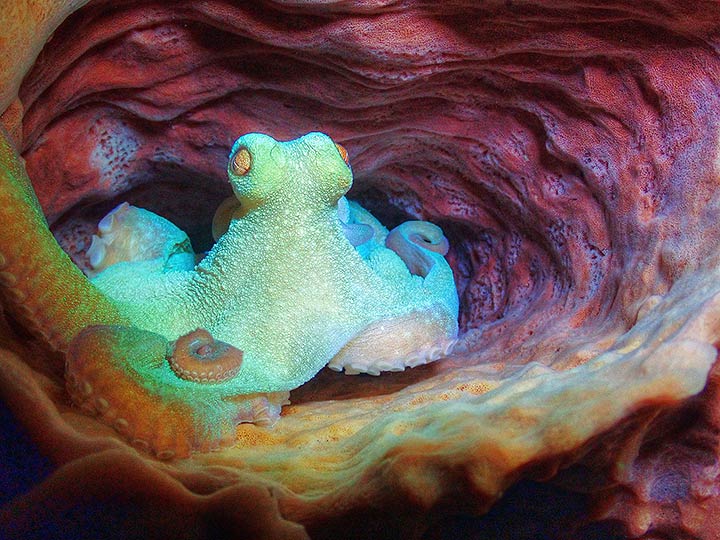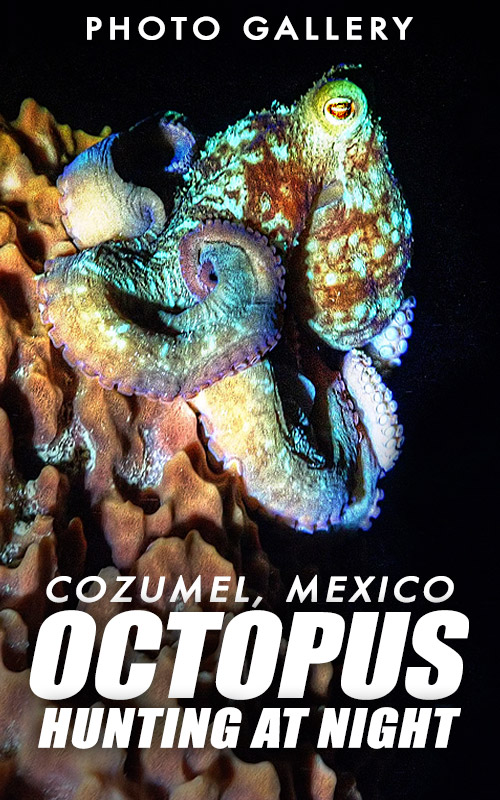The Caribbean reef octopus is almost exclusively a nocturnal hunter. You could go fifty dives during the day without seeing one, but you'll probably see several on any night dive on almost any Caribbean reef. They are incredible to watch, especially when they change color and texture, and it can be tough to believe what your eyes are seeing.
After the sun sets, the protected reefs of Cozumel's marine park are crawling with these eight-legged aliens. On every night dive, I saw at least five or six octopus. On one really special dive, I lost count after seeing 14 or 15, and we must have seen over two-dozen different octopus. Literally every two minutes of the dive, there'd be another octopus hunting on the reef.

The Caribbean island of Cozumel off the Yucatan coast of Mexico is a very popular dive destination with its incredible coral reefs. A consistent longshore current keeps the visibility clear and usually spectacular. Scuba diving in the current, known as drift diving, is fun but requires advanced dive skills.
First, it's almost impossible to kick against the current for very long. Instead, you might be able to make it back up current by swimming sideways or diagonally. Sometimes the strong current pushes you right off the deep end of the wall. New divers can get dangerously deep very quickly, so good buoyancy control is important.
Diving at night, the currents usually lighten up, but sometimes they will get even stronger. Divers must be prepared for variable conditions. Some dive shops will take you on a sunset dive, and then head back closer for the second dive. If it's just one dive, you might depart a little later. The night dive reef is located right outside the boat harbor.
Once the sun has set, the nocturnal Caribbean reef octopus emerge from their dens to hunt. They are quite fun to watch as they jump from coral head to coral head, flaring their webbing, and using each of their limbs to scare their prey from their hiding spot, and right into the waiting beak of the hungry octopus.

Night dives are one of my favorite types of dives, especially for underwater photography. It is much easier to control how much light your lens processes when there is no giant fireball in the sky above. With the clear visibility of Cozumel, the conditions underwater can be too bright during the day making photography difficult.
Night diving carries additional risk. Make sure you stay close to your buddy. Even though you can easily see their dive light, it is more challenging to see if someone has a problem. I also recommend bringing an extra light on your dive just in case your primary dive light battery runs out, or if you drop your light and it goes too deep to recover. A wrist halyard is a good idea.
Don't blind your dive buddy, or the animals you see at night. Be careful not to shine your dive light into the eyes of other divers, and the fish don't like it either. The best technique is to shine the main beam just in front or to the side of the animal you are trying to view. You can also use a red light which allows you to see, but doesn't disturb the wildlife.
First of all, there is a no standard or possibly correct term for a group of more than one octopus, because they are mostly solitary animals, unlike a school or shoal of fish, so it simply does not apply. But how do we simply indicate more than one octopus?
What is the "correct" plural? Octopi or Octopus or Octopodes or ?
I challenge you to find another word
The provocative James Bond version is rarely mentioned, but a commonly heard plural of octopus is "octopi" which is pseudo-Latin and definitely not correct, however octopi has been in use longer than "octopuses" which is the Anglicized plural, and also incorrect.
The word octopus comes from oktopous, which is a Greek word -- okto translates to eight, and pous for foot. In Greek, the plural for pous is podes, so the most proper or "correct" plural for octopus -- strictly speaking -- be octopodes.
No, the last part of octopodes does not rhyme with toads as seems to be the common assumption. Phonetically, octopodes would be pronounced more like "oak-TOPE-it-teez" with the emphasis on the second syllable.
However, given that octopodes has never been widely used, every other option is also available, though all are clumbsy. In scientific and conservation contexts, the plural of octopus is octopus.
There is also some debate what plural was actually used originally in Greek. Much like in English, some plural versions of words stay the same as the singular. For example, multiple deer are still called deer, not deers. There are plenty of examples that seems to suggest in ancient Greece, multiple oktopous were still called oktopous.
Since language is not usually intended to complicate comprehension and communication, I believe that octopodes would not be the best choice, but rather, to use octopus as both the singular and plural.
In Mexico, octopus is called pulpo, and the plural is simply pulpos, however, pulpo can also be used to indicated multiple octopus. Que sera sera...